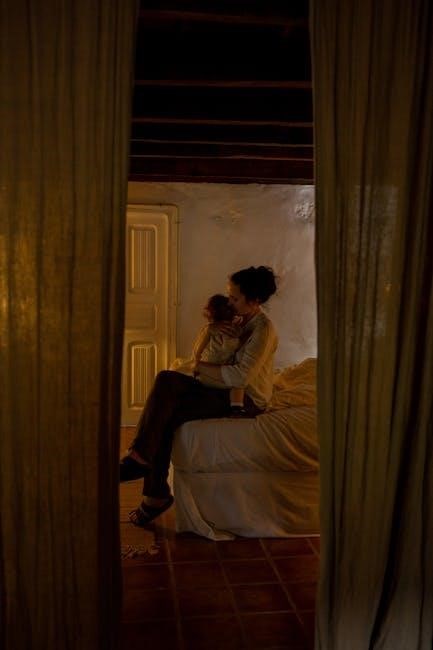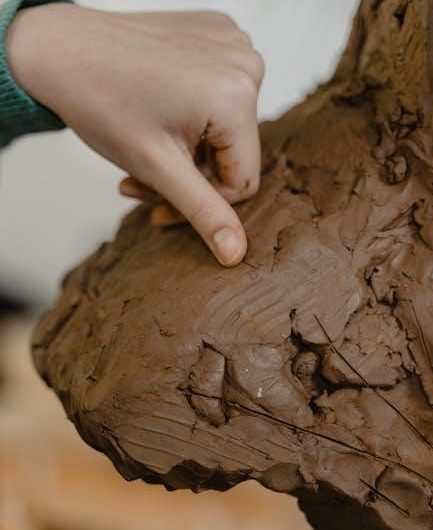
The novel is available in various digital formats, including PDF, offering readers convenience and accessibility. Its themes resonate deeply, making it a popular choice for academic studies and book discussions worldwide.
1.1 Overview of the Novel
The Tortilla Curtain, written by T. Coraghessan Boyle, is a thought-provoking novel that explores themes of immigration, social inequality, and the American Dream. The story intertwines the lives of two contrasting couples: Delaney and Kyra Mossbacher, wealthy Los Angeles liberals, and Candido and America Rincon, undocumented Mexican immigrants. Through their experiences, Boyle examines the clash of privilege and poverty, offering a poignant yet satirical look at societal divides. The novel is widely available in PDF format, making it accessible for readers worldwide.
1.2 Author Background: T. Coraghessan Boyle
T. Coraghessan Boyle is a renowned American novelist and short-story writer, born on December 2, 1948, in Peekskill, New York. Known for his versatile and provocative storytelling, Boyle explores themes of social justice, human relationships, and cultural conflicts. His writing often blends satire, irony, and a deep understanding of human nature. Boyle’s work, including The Tortilla Curtain, has been widely acclaimed for its bold narrative style and its ability to challenge societal norms and expectations.
1.3 Publication and Reception
The Tortilla Curtain was published in 1995 by Viking Press, quickly becoming a subject of significant discussion due to its controversial themes. The novel was praised for its bold exploration of immigration, privilege, and societal divides, with many critics lauding Boyle’s sharp prose and nuanced character development. However, some reviewers criticized its portrayal of undocumented immigrants, arguing it lacked depth. Despite this, the book remains a pivotal work in Boyle’s oeuvre, offering a poignant and thought-provoking examination of the American Dream and its disillusionments.

Plot Summary
The novel intertwines the lives of two contrasting couples, exploring their collisions and struggles, which unfold through shifting narrative perspectives and pivotal events.
2.1 The Lives of Two Couples
The novel follows the lives of two contrasting couples: Delaney and Kyra Mossbacher, wealthy Los Angeles liberals, and Candido and America Rincon, undocumented Mexican immigrants. Their worlds collide unexpectedly, revealing stark differences in privilege, struggle, and perception. Delaney’s idealism clashes with Kyra’s pragmatism, while Candido and America face daily survival challenges. The narrative explores their intersecting lives, highlighting themes of immigration, identity, and societal divides, ultimately leading to a tragicomedy of misunderstandings and shared human struggles.
2.2 The Collision of Worlds
The novel’s central conflict arises when Delaney Mossbacher accidentally hits Candido Rincon with his car, sparking a chain of events that intertwines the lives of the two couples. This collision symbolizes the broader clash between privilege and poverty, legality and illegality. Delaney’s guilt and Kyra’s pragmatic responses contrast sharply with Candido’s desperation and America’s resilience. The incident exposes deep societal divides, highlighting themes of immigration, class, and the fragile coexistence of disparate worlds in contemporary America.
2.3 Key Events and Turning Points
The collision between Delaney and Candido sparks a series of pivotal events, including America’s determination to secure a better life and Candido’s relentless struggle for stability. Delaney’s internal conflict between his liberal ideals and the harsh realities of immigration adds depth to the narrative. These turning points highlight the tension between privilege and poverty, ultimately leading to a tragic confrontation that reshapes the lives of both couples and underscores the novel’s exploration of societal divides.

Themes Explored in the Novel
The novel explores themes of immigration, identity, social inequality, and the American Dream, highlighting the intersection of privilege and poverty in a poignant yet satirical manner.
3.1 Immigration and Identity
The novel vividly portrays the struggles of Mexican immigrants Candido and America Rincon, exploring themes of identity and resilience. Their undocumented status and precarious living conditions highlight the harsh realities of immigration. Boyle critiques societal attitudes, particularly in the context of Proposition 187, which denied public services to undocumented immigrants. Through their experiences, the novel humanizes the immigrant struggle, emphasizing their quest for dignity and survival in a hostile environment shaped by legal and social barriers.
3.2 Social Inequality and Privilege
The novel starkly contrasts the privileged lives of the Mossbachers with the struggles of Candido and America Rincon, exposing deep social inequalities. The Mossbachers’ wealth and liberal ideals are juxtaposed with the Rincons’ poverty and marginalization, highlighting systemic disparities. Boyle critiques the hypocrisy of privilege, as characters like Delaney Mossbacher advocate for progressive causes while failing to address the realities of inequality. The novel underscores how societal structures perpetuate inequality, particularly through policies like Proposition 187, which further marginalizes undocumented immigrants. Boyle’s satire exposes the complacency of the privileged and the resilience of those denied access to the American Dream.
3.3 The American Dream and Disillusionment
The novel examines the illusion of the American Dream, particularly for Mexican immigrants like Candido and America Rincon. Their pursuit of prosperity is met with hardship and exploitation, contrasting sharply with the Mossbachers’ affluent lifestyle. Boyle reveals the disillusionment faced by immigrants, highlighting systemic barriers that prevent their upward mobility. The Mossbachers, despite their privilege, experience their own disillusionment, as their ideals clash with reality. The novel critiques the notion of equal opportunity, exposing the gaps between the American Dream’s promise and its actual attainment.

Character Analysis
The novel delves into the complexities of its characters, exploring their motivations, conflicts, and growth. Delaney’s liberalism contrasts with Candido’s resilience, while Kyra and America navigate their realities, revealing deep humanity and struggle.
4.1 Delaney Mossbacher: The Liberal Humanist
Delaney Mossbacher, a self-proclaimed liberal humanist, embodies the contradictions of privilege and idealism. His progressive views often clash with his actions, revealing a disconnect between his beliefs and reality. As a wealthy Los Angeles resident, Delaney’s life intertwines with that of Candido Rincon, an undocumented immigrant, forcing him to confront his own biases and the harsh truths of social inequality. His journey from complacency to awareness highlights the complexities of privilege and the challenges of true empathy. The novel portrays his transformation as a microcosm of societal struggles with race, class, and identity, offering a nuanced exploration of humanism in practice.
4.2 Kyra Mossbacher: The Pragmatic Partner
Kyra Mossbacher, Delaney’s wife, is a pragmatic and ambitious real estate agent whose focus on wealth and status contrasts with her husband’s idealism. Her practical nature often leads to tension in their relationship, as she prioritizes security and material comfort over Delaney’s ethical dilemmas. Despite her tough exterior, Kyra’s interactions with the Rincon family reveal a deeper complexity, challenging her to confront the realities of privilege and inequality. Her character serves as a foil to Delaney, highlighting the struggles of maintaining a progressive facade in a privileged world.
4.3 Candido Rincon: The Struggling Immigrant
Candido Rincon, a Mexican immigrant, embodies the resilience and desperation of those seeking a better life. His illegal status and financial struggles highlight the harsh realities of undocumented workers. Candido’s pride and determination often clash with his dire circumstances, creating a complex portrayal of survival; His relationship with America, his wife, underscores the emotional toll of their precarious existence. Through his character, Boyle critiques societal indifference and the systemic barriers faced by immigrants, offering a poignant exploration of human resilience in the face of adversity.
4.4 America Rincon: The Resilient Survivor
America Rincon, Candido’s wife, is a symbol of endurance and adaptability. Her strength lies in her ability to navigate the challenges of illegal immigration, poverty, and exploitation. Despite constant setbacks, she remains determined to create a better life for herself and her family. America’s resilience highlights the unseen struggles of immigrant women, who often bear the emotional and physical burdens of survival. Her character serves as a powerful testament to the human spirit’s capacity to endure and hope in the face of overwhelming adversity.

Symbolism and Metaphors
The novel employs rich symbolism, with the “tortilla curtain” itself representing the divide between social classes and cultures. Boyle uses satire and irony to highlight societal contradictions and hypocrisies, while the setting mirrors the characters’ inner struggles, emphasizing themes of isolation and disparity.
5.1 The Significance of the Title
The title The Tortilla Curtain serves as a powerful metaphor for the divide between privilege and poverty, echoing the “Iron Curtain” but in a U.S.-Mexico border context. It symbolizes the invisible yet impenetrable barrier separating the Mossbachers’ affluent world from the struggles of Candido and America. This curtain represents isolation, inequality, and the clash of cultures, highlighting the novel’s central themes of immigration and social disparity.
5.2 The Use of Satire and Irony
Boyle employs satire and irony to critique societal hypocrisy, particularly through Delaney Mossbacher, a liberal humanist whose ideals clash with his actions. The novel mocks the privilege of the wealthy and the systemic exploitation of immigrants, using irony to highlight the absurdity of their intersecting worlds. Boyle’s sharp wit and tragicomic tone underscore the moral ambiguity of characters like Delaney, who preaches tolerance but fails to practice it, revealing the deep-seated flaws in his progressive facade.
5.3 The Role of Setting in the Narrative
The novel’s setting in California highlights the stark contrast between privilege and poverty. The gated community of Arroyo Blanco represents wealth and insulation, while the canyon where Candido and America live symbolizes marginalization. The border serves as both a physical and symbolic divide, reflecting the characters’ struggles with identity, legality, and social inequality. Boyle uses the setting to emphasize the clash between two worlds, underscoring the themes of immigration and the American Dream through the characters’ interactions with their environment.

Cultural and Historical Context
The novel reflects the tensions surrounding Proposition 187 and the U.S.-Mexico border, exploring themes of immigration and identity. The PDF highlights these real-world issues.
6.1 Proposition 187 and Its Impact
T.C. Boyle’s The Tortilla Curtain was written in response to California’s Proposition 187, a controversial 1994 law denying public services to undocumented immigrants. The novel critiques the law’s divisive impact, portraying the struggles of Candido and América Rincon, Mexican immigrants navigating a hostile system. The PDF version of the book highlights Boyle’s exploration of this era’s xenophobia and inequality, offering a poignant commentary on the human cost of such policies and their broader societal implications.
6.2 The Border as a Symbolic Divide
The U.S.-Mexico border in The Tortilla Curtain serves as a powerful metaphor for division, separating worlds of privilege and poverty. The PDF version underscores how this barrier symbolizes cultural, economic, and legal disparities. Boyle uses the border to explore themes of identity and exclusion, highlighting the struggles of immigrants like Candido and América. This divide not only reflects physical separation but also the emotional and societal chasm between communities, emphasizing the novel’s critique of inequality and the immigrant experience.
6.3 The Chicano Literary Tradition
The Tortilla Curtain intersects with the Chicano literary tradition by exploring themes of identity, marginalization, and the immigrant experience. Boyle’s work resonates with this tradition through its portrayal of Mexican immigrants’ struggles and the societal barriers they face. The novel critiques systemic inequality and cultural divides, aligning with the tradition’s focus on social justice and the voices of the underrepresented. Its use of satire and poignant storytelling reflects the tradition’s commitment to shedding light on the complexities of the Chicano experience.

Literary Style and Technique
Boyle employs a tragicomedy style, blending humor with poignant social critique, while his satirical tone underscores the contradictions of privilege and poverty in contemporary society.
7.1 Narrative Structure and Perspective
The novel employs a non-linear narrative structure, alternating between the perspectives of Delaney Mossbacher and Candido Rincon. This dual viewpoint creates a balanced exploration of conflicting worlds, highlighting the tensions between privilege and poverty. Boyle’s use of shifting narratives allows readers to experience the story from both sides of the social divide, fostering empathy and understanding. The alternating chapters build tension and underscore the inevitable collision of lives, while providing a nuanced portrayal of each character’s struggles and motivations.
7.2 Language and Tone
Boyle’s language in The Tortilla Curtain is sharp and evocative, blending humor with a critical tone. The novel’s tragicomedy reflects the absurdity of societal contradictions, while its vivid descriptions bring the characters’ struggles to life. The tone shifts between irony and empathy, capturing the complexities of human behavior. Boyle’s prose is both poetic and direct, creating a narrative that is engaging yet thought-provoking, drawing readers into the clash of worlds and the moral dilemmas faced by the characters.
7.3 The Use of Tragicomedy
Boyle masterfully employs tragicomedy to explore the clash of privilege and poverty in The Tortilla Curtain. The novel balances humor with poignant struggles, highlighting the absurdity of societal divides. Through characters like Delaney and Candido, Boyle juxtaposes comedic moments with tragic realities, creating a narrative that is both entertaining and thought-provoking. This blend of genres underscores the moral complexities and human frailties, making the story relatable and emotionally resonant while addressing deeper social issues.

Critical Reception and Reviews
The novel received critical acclaim for its thought-provoking exploration of immigration and social divides. It won the PEN/Faulkner Award and remains a popular choice for academic studies.
8.1 Positive Reviews and Accolades
Critics praised The Tortilla Curtain for its bold narrative and nuanced characters. The novel earned the PEN/Faulkner Award, highlighting Boyle’s masterful storytelling and timely themes. Reviewers noted its ability to blend humor with poignant societal commentary, making it both entertaining and thought-provoking. The PDF version has been widely downloaded, ensuring its accessibility to a broad audience. This recognition solidified its place in contemporary American literature.
8.2 Critical Analysis of the Novel’s Themes
Scholars and critics have praised The Tortilla Curtain for its incisive exploration of themes such as immigration, identity, and social inequality. The novel’s portrayal of contrasting lives—wealthy liberals and undocumented immigrants—highlights the stark divide between privilege and poverty. Boyle’s use of satire and irony underscores the systemic issues faced by marginalized communities. The PDF version of the novel has been widely analyzed in academic circles, with many appreciating its nuanced examination of the American Dream and its disillusionment; The text remains a vital commentary on contemporary societal challenges.
8.3 Comparisons to Other Works by Boyle
T.C. Boyle’s The Tortilla Curtain shares thematic similarities with his other works, such as Drop City and The Road to Wellville, which also explore societal divides and human frailty. Boyle’s signature blend of satire and poignant storytelling is evident here, as it is in his earlier novels. The PDF version of The Tortilla Curtain has been particularly noted for its sharp critique of privilege and immigration, resonating with readers familiar with Boyle’s provocative style and his ability to tackle controversial topics with depth and nuance.

Adaptations and Interpretations
The Tortilla Curtain has been optioned for a premium series adaptation by HertzbergMedia and Nice Media, highlighting its enduring relevance. Its PDF availability enhances accessibility for global readers, fostering diverse interpretations and discussions about its themes and characters.
9.1 The Novel as a Potential Film or Series
The Tortilla Curtain has been optioned for a premium series adaptation by HertzbergMedia and Nice Media, with writer and producer Olsen attached to the project. Its rich, layered narrative and complex characters make it an ideal candidate for a screen adaptation. The story’s exploration of immigration, privilege, and cultural clashes aligns with contemporary themes, offering deep dramatic potential. A film or series adaptation would further amplify the novel’s impact, reaching a broader audience and sparking new discussions about its timely issues.
9.2 Reader Responses and Book Club Discussions
Readers worldwide have embraced The Tortilla Curtain, with many book clubs selecting it for its thought-provoking themes. The PDF format has made it easily accessible for discussions, fostering debates on immigration, privilege, and identity. Boyle’s ability to inhabit diverse perspectives has sparked praise and reflection, particularly in how it humanizes complex issues. The novel’s emotional depth and timely relevance continue to resonate, making it a favorite for book clubs seeking meaningful conversations about contemporary societal challenges.
9.3 Academic Studies and Essays
The Tortilla Curtain has become a focal point in academic studies, particularly in discussions of immigration, identity, and social inequality. Scholars often cite Boyle’s nuanced portrayal of contrasting worlds, highlighting its relevance to contemporary debates. The novel’s exploration of the American Dream and disillusionment has sparked numerous essays, with many analyzing its place in the Chicano literary tradition. The availability of the PDF version has further facilitated its use in research, with study guides and critical essays widely accessible online for deeper analysis.

The novel is widely available in PDF format, enabling easy access for readers. Downloadable from various platforms, it offers convenience and flexibility for digital reading experiences worldwide.
10.1 Availability and Download Options
The Tortilla Curtain PDF is readily available for download on various platforms, including Google Books, Amazon, and Project Gutenberg. Readers can access it free of charge on some sites or purchase it through official retailers. Additionally, many online libraries offer the novel in digital formats like EPUB and MOBI, ensuring compatibility with e-readers and mobile devices. Some websites also provide reading guides and study materials, enhancing the reader’s understanding of Boyle’s work. However, be cautious of third-party sites to ensure copyright compliance and support authors appropriately.
10.2 Reading Guides and Study Materials
Reading guides and study materials for The Tortilla Curtain PDF are widely available online. These resources provide in-depth analyses of the novel’s themes, characters, and literary techniques. Many educational websites offer downloadable PDF guides, while others include interactive tools for better comprehension. Additionally, some platforms provide chapter summaries, discussion questions, and essay prompts, making it easier for students and readers to engage with Boyle’s work. These materials are often free or low-cost, accessible through academic databases or publisher websites.
10.3 Digital Formats and Accessibility
The Tortilla Curtain PDF is accessible across various digital formats, including EPUB, MOBI, and TXT. Readers can download these formats from online libraries and book platforms, ensuring compatibility with e-readers, tablets, and smartphones. Additionally, many websites offer the novel for online reading through built-in e-readers, eliminating the need for downloads. This accessibility makes the book readily available to a global audience, supporting diverse reading preferences and technological capabilities. The PDF version is particularly popular for its clarity and ease of use.
The Tortilla Curtain PDF remains a vital resource, offering readers easy access to Boyle’s poignant exploration of immigration and social divides, ensuring its themes resonate widely.
11.1 The Novel’s Lasting Impact
T.C. Boyle’s The Tortilla Curtain continues to resonate as a powerful commentary on immigration and social inequality. Its exploration of clashing worlds and the human condition remains deeply relevant. The novel’s ability to provoke thought and empathy ensures its lasting impact. The availability of the Tortilla Curtain PDF has further amplified its reach, making it accessible to a wider audience and solidifying its place in contemporary literary discourse about identity and privilege.
11.2 Final Thoughts on the Themes and Characters
The Tortilla Curtain masterfully explores themes of immigration, identity, and social inequality through its complex characters. Delaney and Kyra Mossbacher represent privilege and liberalism, while Candido and America Rincon embody resilience and struggle. The novel’s emotional depth and satirical tone leave a lasting impression, urging readers to reflect on societal divides. The Tortilla Curtain PDF ensures accessibility, allowing these poignant themes to reach a broader audience and continue sparking essential conversations about humanity and justice.
11.3 Recommendations for Further Reading
For deeper insights into immigration and social themes, readers of The Tortilla Curtain PDF may enjoy T.C. Boyle’s other works, such as Without a Hero and Drop City. Additional recommendations include The House on Mango Street by Sandra Cisneros and The Brief Wondrous Life of Oscar Wao by Junot Díaz, which explore similar cultural and identity themes. These works, available in various formats, offer a rich understanding of the immigrant experience and societal challenges, fostering further reflection and discussion.
 norwegian sun deck plan pdf
norwegian sun deck plan pdf  free disc personality test pdf
free disc personality test pdf  body language pdf
body language pdf  aperture shutter speed iso chart pdf
aperture shutter speed iso chart pdf  valentía 2 libro pdf descargar gratis
valentía 2 libro pdf descargar gratis  kenmore oven manual model 790
kenmore oven manual model 790